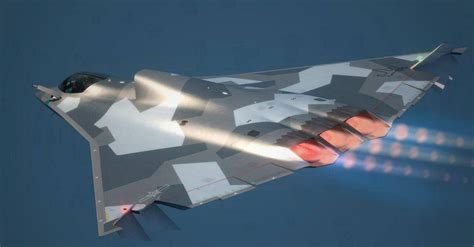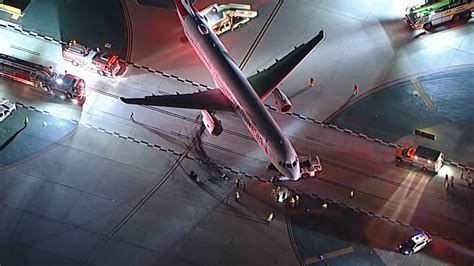
New images of what is believed to be China’s J-36 stealth fighter jet have surfaced, offering aviation enthusiasts and military analysts the clearest views yet of the advanced aircraft. The images, circulating on social media, provide unprecedented detail of the J-36’s design, potentially revealing insights into the platform’s capabilities and intended role within the People’s Liberation Army Air Force (PLAAF).
The high-resolution photographs showcase the J-36’s sleek, low-observable design, characterized by its stealth-optimized airframe, which shares visual similarities with both the American F-35 and the Chinese J-31. The fighter’s features, including its sharply angled surfaces, internal weapons bay, and radar-absorbent coatings, strongly suggest a focus on minimizing radar cross-section, a key attribute of fifth-generation stealth fighters.
These images are significant because prior sightings of the J-36 have been limited and often of poor quality, leaving many details of the aircraft obscured. While the J-36 is believed to be a development of the earlier FC-31, also known as the J-31, the new imagery suggests considerable advancements and design refinements. Analysts are now scrutinizing the details to determine the extent of these upgrades and their potential impact on the aircraft’s performance.
The J-36 is speculated to be intended for a variety of roles, including carrier-based operations on China’s growing fleet of aircraft carriers, as well as land-based missions to project power and defend China’s expanding interests. Its potential deployment on carriers, such as the Liaoning, Shandong, and the future Type 003, could significantly enhance the PLAAF’s naval aviation capabilities. Some experts suggest the J-36 could complement the heavier J-20 stealth fighter, providing a more versatile and cost-effective option for certain missions.
The release of these images also comes amid heightened geopolitical tensions in the Indo-Pacific region, where China is asserting its territorial claims and expanding its military presence. The development and deployment of advanced platforms like the J-36 underscore China’s commitment to modernizing its armed forces and narrowing the technological gap with the United States and other major powers.
The J-36, if proven to meet performance expectations, could pose a significant challenge to existing U.S. and allied airpower in the region. Its stealth capabilities, combined with advanced sensors and weapons, would require a reassessment of existing defense strategies and potentially spur further investment in counter-stealth technologies.
“These images provide the most detailed look we’ve had at the J-36 to date,” said a military analyst who specializes in Chinese military aviation, speaking on condition of anonymity. “The design features are consistent with a fifth-generation stealth fighter, but the true test will be its performance in operational environments.”
The images also offer clues to the aircraft’s engine configuration, avionics, and sensor suite, although detailed analysis will require further data and intelligence. Experts are comparing the J-36’s design with other stealth fighters, such as the F-35 and F-22, to assess its relative strengths and weaknesses.
The emergence of these images coincides with ongoing debates about the future of airpower and the increasing importance of stealth technology in modern warfare. As China continues to develop and deploy advanced military platforms, the balance of power in the Indo-Pacific region could shift, requiring the United States and its allies to adapt and innovate to maintain their strategic advantage.
The specifics of the J-36’s avionics and electronic warfare capabilities remain largely unknown, though it is expected to incorporate advanced radar, electronic countermeasures, and data fusion systems. These technologies are crucial for detecting, tracking, and engaging enemy aircraft and missile systems in contested environments.
The J-36’s development also reflects China’s broader efforts to become more self-reliant in military technology. For years, China has relied on foreign sources for certain critical components and technologies, but it is now investing heavily in indigenous research and development to reduce its dependence on others.
The unveiling of the J-36 images has prompted discussions among military experts and policymakers about the implications for regional security and the potential for arms racing in the Indo-Pacific. Some analysts warn that China’s military buildup could lead to increased instability and the risk of conflict, while others argue that it is a natural consequence of China’s growing economic and political power.
The impact of the J-36 on U.S. and allied defense strategies will depend on its actual capabilities and deployment patterns. The U.S. military is already developing new technologies and tactics to counter stealth aircraft, including advanced radar systems, electronic warfare capabilities, and directed energy weapons.
The new images of the J-36 will undoubtedly fuel further speculation and analysis, but they also serve as a reminder of China’s growing military capabilities and its determination to become a major player on the global stage. The future of airpower in the Indo-Pacific will likely be shaped by the ongoing competition between China and the United States, and the development of advanced platforms like the J-36 will play a key role in this competition.
The aerodynamic design of the J-36 also appears to incorporate features aimed at enhancing its maneuverability and supersonic performance. This could include carefully shaped wings, control surfaces, and engine inlets designed to optimize airflow and reduce drag. These features would be critical for engaging enemy aircraft in aerial combat and evading missile threats.
The J-36’s internal weapons bay capacity and payload configurations remain a closely guarded secret, but analysts speculate that it could carry a variety of air-to-air missiles, air-to-surface missiles, and precision-guided bombs. The ability to carry a diverse range of weapons would enhance the J-36’s versatility and allow it to perform a wide range of missions.
The J-36 is not the only advanced fighter jet in development in China. The J-20, China’s first fifth-generation stealth fighter, is already in service with the PLAAF and is being continuously upgraded with new technologies and capabilities. The J-36 could complement the J-20, providing a more affordable and versatile option for certain missions.
The development of the J-36 also has implications for the global market for fighter jets. If the J-36 proves to be competitive with other fifth-generation fighters, it could become an attractive option for countries seeking to modernize their air forces. This could lead to increased competition in the global arms market and potentially shift the balance of power in certain regions.
The release of the J-36 images has also prompted discussions about the role of social media and open-source intelligence in tracking military developments. The images were initially circulated on social media platforms and were quickly picked up by military analysts and journalists. This highlights the increasing importance of open-source intelligence in understanding global security trends.
The J-36 represents a significant milestone in China’s military modernization efforts. It demonstrates China’s growing capabilities in aerospace engineering and its commitment to developing advanced military technologies. The J-36 will likely play a key role in shaping the future of airpower in the Indo-Pacific region and beyond.
The type of steel, alloys, and composite materials used in the construction of the J-36 also remain a key element of understanding its capabilities. The structural integrity of the aircraft, its ability to withstand high-stress maneuvers, and its longevity are all directly linked to the materials used in its construction. Gaining insights into these aspects is crucial for a comprehensive evaluation.
The cooling systems used in the J-36 are also a critical factor, particularly for a stealth aircraft that generates a significant amount of heat. Effective thermal management is essential for reducing the aircraft’s infrared signature and preventing overheating of its sensitive electronic components.
The overall life-cycle cost of the J-36, including maintenance, training, and upgrades, will also be a key factor in determining its long-term viability. China will need to ensure that the J-36 is not only technologically advanced but also affordable to operate and maintain.
The political implications of the J-36’s development are also significant. The J-36 is a symbol of China’s growing power and influence, and its deployment could be seen as a challenge to the United States and its allies. This could lead to increased tensions in the Indo-Pacific region and potentially spark an arms race.
The J-36 is a complex and multifaceted project with far-reaching implications. Its development reflects China’s growing military capabilities and its ambition to become a major global power. The J-36 will likely play a key role in shaping the future of airpower in the Indo-Pacific region and beyond.
“The development of the J-36 underscores China’s commitment to modernizing its armed forces and narrowing the technological gap with the United States and other major powers,” observed another defense analyst.
The electronic warfare suite on the J-36, if advanced, could allow it to jam enemy radar systems, disrupt communications, and even spoof enemy missiles, significantly enhancing its survivability and effectiveness in combat. The integration of artificial intelligence into the J-36’s systems could also enable it to make faster and more accurate decisions in complex combat situations.
The supply chain for the J-36 is also an important consideration. China needs to ensure that it has a secure and reliable supply of critical components and materials, both domestically and from trusted foreign sources. Any disruptions to the supply chain could delay production and impact the aircraft’s operational readiness.
The training of J-36 pilots will also be crucial for its success. Pilots will need to be highly skilled and experienced in order to operate the aircraft effectively and take full advantage of its advanced capabilities. China will need to invest heavily in pilot training programs to ensure that it has a sufficient number of qualified pilots to fly the J-36.
The integration of the J-36 into the PLAAF’s broader network of sensors and weapons systems will also be essential. The J-36 will need to be able to communicate seamlessly with other aircraft, ships, and ground-based systems in order to share information and coordinate operations effectively.
The development of the J-36 is a long-term project that will require sustained investment and innovation. China will need to continue to refine and improve the aircraft’s design, systems, and capabilities in order to maintain its competitive edge.
The J-36 is not just a military asset; it is also a symbol of national pride and technological prowess. Its development reflects China’s growing confidence and its determination to become a leading global power.
The international reaction to the J-36 has been mixed. Some countries have expressed concern about China’s growing military power, while others have welcomed the development as a sign of China’s increasing engagement in global affairs.
The long-term impact of the J-36 on the balance of power in the Indo-Pacific region remains to be seen. However, it is clear that the J-36 will play a significant role in shaping the future of airpower in the region.
Frequently Asked Questions (FAQs)
1. What is the J-36?
The J-36 is believed to be a new stealth fighter jet developed by China. It is speculated to be a development of the earlier FC-31/J-31 and is designed to have low-observable characteristics, making it difficult to detect by radar. It is considered a fifth-generation fighter, similar to the U.S. F-35.
2. What are the key features of the J-36?
Based on the recent images, the J-36 features a sleek, stealth-optimized airframe with sharply angled surfaces, internal weapons bays, and radar-absorbent coatings. These features are designed to minimize its radar cross-section. It is speculated to have advanced avionics, electronic warfare capabilities, and a powerful engine.
3. What is the J-36’s intended role?
The J-36 is speculated to be intended for a variety of roles, including carrier-based operations on China’s aircraft carriers and land-based missions for power projection and defense. Some analysts believe it could complement the heavier J-20 stealth fighter, providing a more versatile and cost-effective option for certain missions.
4. How does the J-36 compare to other stealth fighters like the F-35?
The J-36 shares visual similarities with the American F-35. While detailed performance data is not yet available, experts are comparing its design features to assess its relative strengths and weaknesses. The true test will be its performance in operational environments, assessing its stealth capabilities, maneuverability, and weapons payload.
5. What are the implications of the J-36 for regional security?
The development and deployment of the J-36 underscore China’s commitment to modernizing its armed forces and narrowing the technological gap with the United States and its allies. This could potentially shift the balance of power in the Indo-Pacific region, requiring the U.S. and its allies to adapt their defense strategies and invest in counter-stealth technologies. It also raises concerns about potential arms racing and increased tensions in the region.
The aircraft’s potential to conduct long-range strike missions against land and sea targets also raises concerns about its impact on regional stability. The J-36 could be used to project power and deter potential adversaries, but it could also be used to intimidate smaller countries and assert China’s territorial claims.
The United States and its allies will need to carefully monitor the development and deployment of the J-36 and take appropriate steps to deter any potential aggression. This could include increasing their own military presence in the region, strengthening their alliances, and developing new technologies to counter the J-36’s capabilities.
The J-36 is a reminder that the balance of power in the Indo-Pacific region is shifting. The United States and its allies will need to adapt to this new reality and work together to maintain peace and stability in the region.
The J-36’s development is also a challenge to the global arms control regime. The aircraft is not covered by any existing arms control agreements, and there is no mechanism in place to limit its production or deployment. This could lead to an arms race in the region, as other countries seek to acquire similar capabilities.
The international community will need to consider new approaches to arms control in order to address the challenges posed by the J-36 and other advanced weapons systems. This could include negotiating new arms control agreements or developing new technologies to monitor and verify arms control compliance.
The J-36 is a complex and multifaceted challenge that requires a comprehensive and coordinated response. The United States and its allies will need to work together to address the military, political, and economic implications of the J-36’s development and deployment.
The J-36 is not just a military asset; it is also a symbol of China’s growing power and influence. Its development reflects China’s ambition to become a major global power and its willingness to invest in advanced military technologies.
The United States and its allies will need to recognize this reality and develop a strategy for managing China’s rise. This will require a combination of containment and engagement, as well as a willingness to work with China on issues of common concern.
The J-36 is a reminder that the world is becoming more multipolar. The United States is no longer the sole superpower, and it will need to work with other countries to address the challenges of the 21st century.
The images reveal the J-36 exhibits a diverterless supersonic inlet (DSI) design, similar to that found on the JF-17 and J-10B fighter jets. DSI inlets are lighter and simpler to manufacture than traditional inlets, reducing radar signature by eliminating the need for a boundary layer splitter. They also enhance supersonic performance. This could indicate a design emphasis on cost-effectiveness and ease of maintenance alongside stealth characteristics.
Furthermore, the images suggest that the J-36 incorporates advanced sensor fusion capabilities. Sensor fusion combines data from multiple sensors – radar, infrared, electronic warfare systems – to create a more comprehensive and accurate picture of the battlespace. This would enhance the pilot’s situational awareness and decision-making abilities.
The Chinese military likely intends to export the J-36, or a derivative of it, to foreign customers, particularly those who are unable or unwilling to purchase American-made fighter jets. This could generate significant revenue for China’s defense industry and strengthen its geopolitical influence.
The precise radar cross-section (RCS) of the J-36 remains unknown. However, its design features strongly suggest that it is significantly lower than that of fourth-generation fighters. Achieving a low RCS requires careful attention to detail in every aspect of the aircraft’s design and construction.
The operational range and payload capacity of the J-36 are also important factors to consider. A longer range would allow the aircraft to project power further afield, while a larger payload capacity would enable it to carry a wider range of weapons and sensors.
The J-36 is likely to be equipped with a range of air-to-air and air-to-ground missiles. These missiles are likely to incorporate advanced guidance systems and warheads, making them highly effective against a variety of targets.
The J-36 is a significant development in China’s military modernization program. It demonstrates China’s growing capabilities in aerospace engineering and its determination to become a major military power. The J-36 will likely play a key role in shaping the future of airpower in the Indo-Pacific region and beyond.
The aircraft’s potential for network-centric warfare is another important consideration. Network-centric warfare involves linking together different military assets – aircraft, ships, ground vehicles – into a single, integrated network. This allows for better coordination and communication, and it can significantly enhance combat effectiveness.
The J-36’s ability to operate in a network-centric environment will depend on its communication systems and its ability to share data with other platforms. It is likely that the J-36 will be equipped with advanced data links and communication systems that allow it to seamlessly integrate into the PLAAF’s network.
The Chinese military is likely to conduct extensive testing and evaluation of the J-36 before it enters operational service. This testing will involve evaluating the aircraft’s performance in a variety of scenarios, including air-to-air combat, air-to-ground attack, and electronic warfare.
The results of these tests will be used to refine the J-36’s design and improve its performance. The Chinese military is likely to be very cautious about introducing the J-36 into operational service until it is confident that it is a reliable and effective weapon system.
The development of the J-36 is a long and complex process. It requires the cooperation of many different organizations and individuals, including engineers, scientists, technicians, and pilots. The Chinese government has made a significant investment in the J-36 program, and it is committed to seeing it through to completion.
The J-36 is a symbol of China’s growing technological prowess and its determination to become a world leader in aerospace engineering. The aircraft is a source of national pride for the Chinese people, and it is seen as a key element of China’s military modernization program.
The release of these images provides valuable insights into the capabilities and design features of the J-36. While many details remain unknown, the images confirm that the J-36 is a sophisticated and advanced fighter jet that represents a significant step forward for China’s military aviation capabilities. The J-36 could alter the existing balance of power in the region.
The engine inlets appear to be designed to shield the engine fan blades from radar waves, further reducing the aircraft’s radar cross-section. The shape and positioning of the vertical stabilizers also contribute to stealth, deflecting radar waves away from potential emitters.
The material composition of the radar-absorbent coatings used on the J-36 is also of great interest to analysts. These coatings are designed to absorb radar waves, preventing them from being reflected back to the radar source. The effectiveness of these coatings depends on their material composition, thickness, and application technique.
The cockpit design of the J-36 is likely to incorporate advanced displays and controls, providing the pilot with a comprehensive and intuitive interface. The cockpit is also likely to be equipped with a helmet-mounted display, which projects information onto the pilot’s visor, allowing them to keep their eyes focused on the target.
The J-36’s electronic warfare suite is likely to include a range of countermeasures designed to protect the aircraft from enemy radar and missiles. These countermeasures could include jammers, chaff, and flares.
The data fusion capabilities of the J-36 are likely to be enhanced by artificial intelligence (AI). AI algorithms can be used to analyze data from multiple sensors and create a more accurate and complete picture of the battlespace. AI can also be used to automate certain tasks, reducing the pilot’s workload and improving their decision-making abilities.
The J-36 is likely to be equipped with a secure data link that allows it to communicate with other aircraft, ships, and ground stations. This data link will enable the J-36 to share information and coordinate operations with other units.
The development of the J-36 is a testament to China’s growing technological capabilities. The aircraft is a sophisticated and advanced weapon system that represents a significant step forward for China’s military aviation. The J-36 is likely to play a key role in shaping the future of airpower in the Indo-Pacific region.
The aircraft, with its stealth capabilities and advanced weaponry, may enable the PLAAF to project power beyond its immediate borders more effectively than before. This could have implications for regional stability and security.
The J-36’s service ceiling, or maximum altitude, is another important factor in its operational capabilities. A higher service ceiling would allow the aircraft to operate in a wider range of environments and engage targets at higher altitudes.
The aircraft’s rate of climb, or how quickly it can gain altitude, is also a key performance metric. A faster rate of climb would allow the aircraft to intercept enemy aircraft more quickly and evade missile threats.
The J-36’s acceleration, or how quickly it can increase its speed, is another important factor in its combat effectiveness. A faster acceleration would allow the aircraft to maneuver more effectively and engage targets more quickly.
The J-36’s turning radius, or how tightly it can turn, is another important factor in its maneuverability. A smaller turning radius would allow the aircraft to outmaneuver enemy aircraft in close-quarters combat.
The J-36’s stall speed, or the minimum speed at which it can maintain lift, is another important factor in its safety and handling characteristics. A lower stall speed would make the aircraft easier to control at low speeds and reduce the risk of stalling.
The J-36’s landing speed, or the speed at which it touches down on the runway, is another important factor in its operational flexibility. A lower landing speed would allow the aircraft to operate from shorter runways and aircraft carriers.
The J-36’s takeoff distance, or the distance it needs to accelerate to takeoff speed, is another important factor in its operational flexibility. A shorter takeoff distance would allow the aircraft to operate from smaller airfields and aircraft carriers.
The J-36’s radar is expected to be an Active Electronically Scanned Array (AESA) radar, which offers superior performance compared to traditional mechanically scanned radars. AESA radars can track multiple targets simultaneously and are more resistant to jamming.









